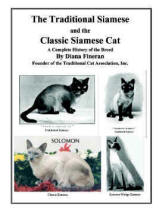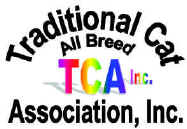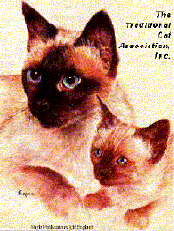|
Departments
eBook now Available!
|
Exclusive - THE book on Traditional & Classic
Siamese cats

Written by the Founder of TCA, Inc.
Tullycrine
Affordable
Web Design
|
|
|
TRADITIONAL JAPANESE
BOBTAIL©®
CLASSIC JAPANESE BOBTAIL©® CAT FAQs
HISTORY -
PERSONALITY - HEALTH
Copyright © Trademark ® Diana Fineran, January 2, 2007
HISTORY
The origin of the Traditional and Classic Japanese Bobtail
is, of coarse, Japan, where they have been the street and farm cats for
1200-2000 years. They protected silk worms, rice and other crops from vermin.
Both the short hair and long hair versions of the breed have existed for
centuries in the Orient. They are naturally occurring breeds. Exactly when the
mutation occurred is unknown, yet it can be said that bob tailed cats are common
in the Orient. The large and cobby Traditional Japanese Bobtail still resides in
Japan today. The smaller, Classic Japanese Bobtail was created in the U.S. from
old bloodlines. They come in both short and long hair varieties.
Deeply imbedded within Japanese culture is the tradition of
keeping within their homes and businesses a usually ceramic cat with its paw
raised. This is the Maneki Neko or beckoning cat, painted with three colors and
possessing a bobbed tail. In the Setagaya suburb of Tokyo, the Gotokuji Temple
is dedicated to the Maneki Neko and has a picture of one on the temples facade.
It was constructed in 1697. The Maneki Neko has long been kept as a talisman or
symbol for good luck or good fortune which is modeled after the Traditional
Japanese Bobtail cat. It can be made of paper mache, fine porcelain or any other
medium. Maneki Nekos were particularly popular in the Edo period (1603-1867). In
Japanese folk lore the Maneki Neko fought off thieves, killed a snake and
performed other heroic deeds to save a princess. It is said when the right hand
paw is raised, it means good fortune in life and business. If the left paw is
raised, it means good fortune with people. It is rare to see one with both paws
raised, so often two are present, each with a different front paw raised to
cover both types of good fortune. John and I have one ourselves, purchased on
one of our many trips to Japan. It presides over our household as a special
greeter of pet lovers who visit.
Old written records document that the domestic cat arrived
in Japan from China or Korea at least one thousand years ago. Conjecture
postulates they were possibly brought to Japan in the Sixth Century during the
reign of Emperor Ido-JO (986-1011) to protect precious manuscripts from mice.
Since then the Traditional Japanese Bobtail has been presented in numerous
ancient prints and paintings. They have been presented on wood block prints,
silk scroll paintings and netsuke, which are small, decorative, carved toggles
to fasten a pouch or purse to the kimono sash. Famous Japanese artists, Chi
Kanoliu (1874), Toyokuni (1786-1864), Hiroshige, Shosan and Hiromi all used the
Traditional Japanese Bobtail in their work.
To further augment the breeds importance a large, 15th
century painting hangs in the Freer Gallery of Art in the Smithsonian Institute
in Washington, D.C, depicting two beautiful, long haired, Traditional Japanese
Bobtails. Their long coats are neatly parted down the back, accented by large
and plumey bobtails.
In 1908 American servicemen returning from Japan were the
first to import the breed to the U.S.
Later three Traditional Japanese Bobtails were imported to
the U.S. from Japan in August, 1968 by Elizabeth Freret (Amulet Cattery), then
an Abyssinian breeder. The three kittens were Judiko’s Madame Butterfly of
Amulet, a tri-color; Judiko’s Richard San of Amulet, a red and white: and an
un-named Cinnamon Tabby. Their arrival as Dulles Airport was preceded by
concentrated efforts over a full years time. The first Traditional Japanese
Bobtail seen by Elizabeth Freret was a red tabby spay, being boarded in a
Maryland pet shop for a service family just back from Japan. Then she met Bess
Higuchi at the Empire show in New York in 1967. Once returned to Japan, Ms.
Higuchi arranged with Judy Crawford, an American living in Hokohama, Japan, to
send the three kittens to Ms. Freret. Out of 36 kittens bred by Ms. Crawford
the three kittens were chosen to be of the very best quality to be the first
imports to the U.S.
Later aficionados were Lynn Beck (Arlynn), Don Thompson
(Do-Don), Virginia Wolfe, Florence Miller (Fongin), George Berkley and
geneticist, Solveig Pfleuger. Ms Wolfs cats, Don & Joanne Thompson’s cats and
George Berkley’s cats all came from Ms Freret.
During the same time frame, when Elizabeth Freret was
importing her cats, Lynn Beck began importing Traditional Japanese Bobtails
through an agent in Tokyo. Both Lynn and her husband had made several trips to
the Orients. The first time Lynn saw a Bobtail was in Japan at an army base in
the Household Pet Class. The Becks imported eight cats, three males and five
females. The help of Judy Crawford was sought out in Japan. The Becks favorite
cat, Obasan, was sent to Ms. Crawford for breeding, but escaped her housing and
was never seen again. Lynn tells her story of smuggling one of her cats, as a
young kitten, on her plane inside a picnic basket, which had been a gift to her
from Osanacha, a Tokyo brothel owner!
A broader gene pool came about through further importations
from Japan. Ms. Freret imported cats from Dr. Masurori Kojuma, a Tokyo
Veterinarian, and Mrs. Alan (Connie) Bath, who was the wife of the Assistant
Naval Attache to the Tokyo Embassy. Jean Kryszcuk of Buffalo, New York received
a male brought back from Japan by a service family. Later breeders included
Charlene Brake (Nekosong), Marianne Clark (Kurisumasu), De Hinkle (Choneko),
Marilyn R. Knopp (MariCho), Barbara Ramonos (Nekolady), Allen Scruggs and
Douglas Myers (Nekomo) all imported from Japan.
“Many street and farm cats in Japan were and still are very
large and cobby. Some have thick coats, especially in Japan’s northern climes.
This type was omitted from American breeding stock.” Allen Scruggs. This
describes the Traditional Japanese Bobtail that TCA, INC. is bringing back due
to the fact that all other cat associations have admittedly omitted the old
style, original Traditional Japanese Bobtail as it always has been in its native
land. The Classic Japanese Bobtail is the smaller body type, developed in the
U.S., so each is embraced and welcome in TCA, INC.
Of course the predominant feature is the tail, which has a
few adjectives connected with it; pom pom, tea cup handle shaving brush, fan,
hook, corkscrew, etc. Since the tail is sensitive, because some parts are
usually fused, it must be handled gently. They do wag their tail too.
All colors are accepted, with or without white. In times
past the Mi-ke (pronounced “mee-kay”) or Calico was prized, but now accepts
equal recognition with all others . Mi-Ke is a Japanese word meaning “three fur”
for the three colors in the cats coat.
PERSONALITY
Active, mischievous and intelligent they enjoy being
talkative cats. Their soft voices are capable of a whole musical scale of
tones. They also have a melodious chant unique to the breed , used when they
want something or are happy. They almost always speak when spoken to.
Since they are great jumpers and climbers a cat tree is
recommended. They could walk on your curtain rods or rest on your shoulders
without a high place to play. They maintain their kittenish ways through out
their lives.
A game of fetch really suits their fancy, because they
enjoy carrying things around in their mouths. From riding on your shoulders to
riding in your car, they enjoy traveling about. Since they adjust to other
animals, dogs and are good with children they make ideal family pets. Some love
water others retrieve.
The full joy of this wonderful, mischief making, breed is
captured by saying they are fun loving, playful, spirited, affectionate,
elegant, beguiling, perky, and exquisite.
HEALTH
The Traditional Japanese Bobtail is a strong and healthy
breed. The breed has a low kitten mortality rate and high disease resistance.
Kittens are not born tailless, nor are they born with full tails. Usually
litters of three or four extremely large kittens are born. A comparison to
other breeds reveals they walk earlier, become active earlier and begin getting
into mischief earlier.
The genes that create the bobbed tail are recessive; Both
parents must be Bobtails in order to produce bob tailed kittens. No known
anomalies accompany the tail creating genes.
Their soundness, health and out standing nature make them
ideal pets.
Top
|
|
|

 The
Traditional Cat Association,
Inc.©1987®TM
Official Website
The
Traditional Cat Association,
Inc.©1987®TM
Official Website